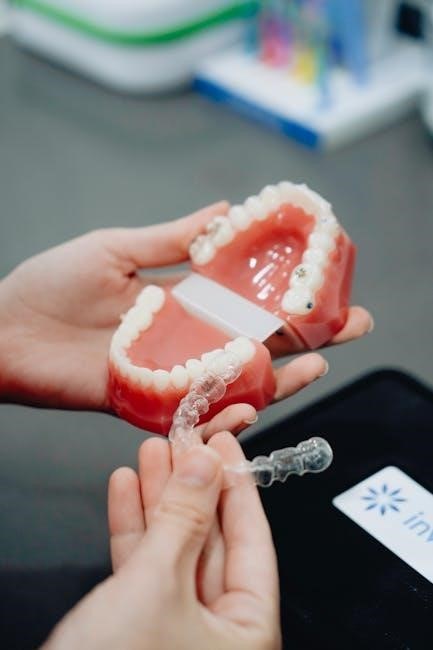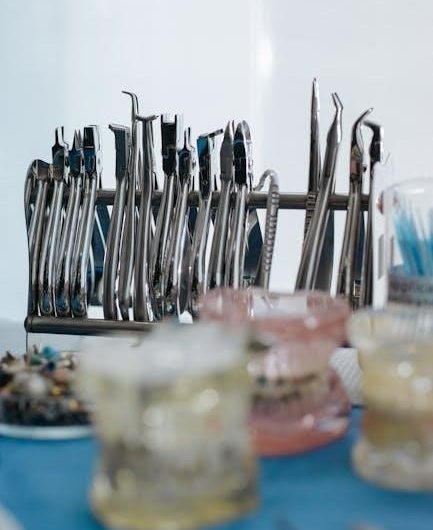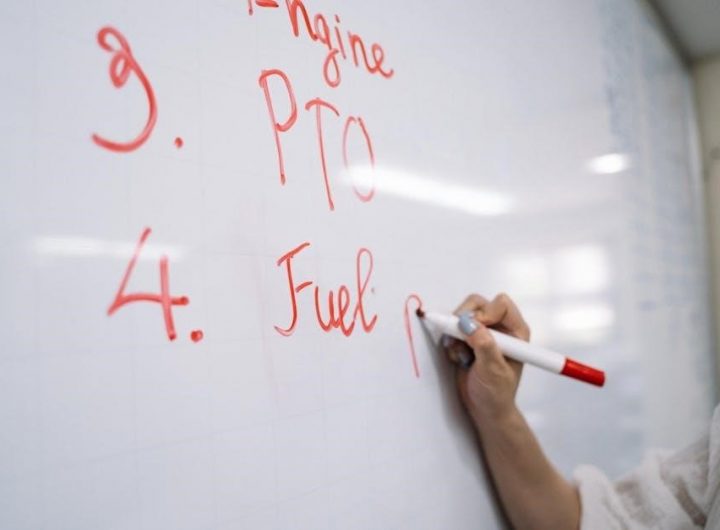
Initial Consultation and Assessment
The initial consultation is a crucial step in the Invisalign process. During this meeting, your dentist will assess your teeth, discuss your goals, and create a personalized treatment plan using 3D imaging to map your tooth movement. This step ensures a tailored approach to achieving your desired smile.
1.1 Importance of the Initial Consultation
The initial consultation is a critical first step in the Invisalign process, allowing your dentist to assess your teeth and determine if Invisalign is the right solution for you. During this meeting, your dentist will discuss your smile goals, address any concerns, and outline the expected outcomes. This step ensures that you are fully informed and comfortable moving forward with treatment. It also provides an opportunity to ask questions and understand how Invisalign works. A thorough assessment is conducted to create a personalized treatment plan tailored to your needs. This initial consultation sets the foundation for a successful and stress-free treatment experience, ensuring you achieve the smile you desire.

1.2 What to Expect During the Assessment

During the assessment, your dentist will conduct a detailed examination of your teeth and bite to determine if Invisalign is suitable for you. This includes taking impressions or scans of your teeth, which are used to create a 3D model of your smile. Your dentist will also discuss your treatment goals and explain how Invisalign can address your specific needs. You can expect to learn about the treatment process, including the number of aligners needed and the expected duration. This step is crucial for creating a personalized plan and ensuring you feel comfortable and informed before starting treatment. It’s also an opportunity to ask questions and address any concerns you may have.
1.3 Discussing Treatment Goals and Expectations
During the initial consultation, your dentist will work with you to set realistic treatment goals and outline what you can expect from the Invisalign process. This discussion ensures that your expectations align with the possible outcomes based on your dental needs. Your dentist will explain how Invisalign works, the timeline, and the importance of consistent wear. They will also address any concerns you may have and provide guidance on maintaining proper oral hygiene throughout treatment. This collaborative approach helps you feel confident and prepared for the journey ahead, ensuring your treatment plan is tailored to achieve the best possible results for your smile.
Creating a Customized Treatment Plan
A personalized treatment plan is developed using 3D imaging to map your tooth movement. Each aligner is tailored to guide your teeth precisely for optimal results.

2.1 Development of a Personalized Dental Plan
The development of a personalized dental plan begins with a detailed assessment of your teeth and bite. Using advanced 3D imaging technology, your dentist creates a precise map of your dental structure. This allows for the design of custom aligners tailored to your specific needs. The plan outlines the exact movement of each tooth, ensuring gradual and effective realignment. You’ll receive a series of aligners, each worn for 10-14 days, to guide your teeth into the desired position. Regular check-ups monitor progress, and adjustments are made as needed to ensure the best results. This personalized approach maximizes comfort and efficiency throughout your Invisalign journey.
2.2 Understanding the Treatment Timeline
The treatment timeline for Invisalign varies depending on the complexity of your case, but most patients wear aligners for 12-24 months. Mild cases may take just a few months, while more complex issues require longer treatment. Each set of aligners is typically worn for 10-14 days before moving to the next. Factors like age, tooth movement speed, and adherence to wear time influence the duration. Regular check-ups every 4-6 weeks allow your dentist to monitor progress and ensure everything is on track. Staying consistent with the recommended wear time and following instructions closely helps maintain the timeline. Understanding the timeline helps set realistic expectations and keeps you motivated throughout the process.
2.3 Role of 3D Imaging in Treatment Planning
3D imaging plays a vital role in Invisalign treatment planning by creating a detailed digital model of your teeth. This technology allows your dentist to visualize your current tooth alignment and predict future movements. The 3D scan is used to design custom aligners that fit precisely, ensuring accurate and efficient tooth movement; It also helps identify potential issues early, enabling adjustments to the treatment plan. Patients can see a virtual representation of their smile transformation, making the process more transparent. The use of 3D imaging enhances precision, customization, and patient engagement, making it a cornerstone of modern orthodontic treatment. This step ensures that your treatment is tailored to your unique needs for the best possible outcome.

Receiving and Fitting Invisalign Aligners
Your custom Invisalign aligners are delivered, and your dentist ensures a proper fit. You’ll receive instructions on wear, care, and handling to begin your treatment confidently.
3;1 First Impressions and Aligner Delivery
When you first receive your Invisalign aligners, your dentist will ensure they fit comfortably and explain how to wear them correctly. This step is crucial for a smooth start to your treatment. You’ll also receive a series of aligners, each designed to gradually move your teeth into the desired position. The delivery process includes instructions on how to handle the aligners, clean them, and monitor progress. Your dentist will address any initial concerns and provide tips to ease into wearing the aligners full-time, ensuring you feel confident and prepared for the journey ahead.
3.2 Proper Insertion and Removal Techniques
Mastering the correct way to insert and remove your Invisalign aligners is essential for comfort and effectiveness. To put them in, start by aligning the tray with your teeth, gently pushing down from the back to the front. Use the “keyhole” technique for a snug fit. For removal, begin at the back, wiggling the aligner from side to side to dislodge it without force. Avoid pulling from the front to prevent bending. Practice in front of a mirror to ensure proper placement. If needed, a removal tool can assist. Proper techniques prevent damage and ensure your aligners stay in good condition, promoting smooth treatment progress and minimizing discomfort.
3.4 Initial Comfort and Adjustment Period
When you first start wearing Invisalign aligners, you may experience mild discomfort or pressure as your teeth begin to shift. This is normal and typically subsides within a few days. The aligners are designed to be gentle on your teeth and gums, unlike metal braces, but an adjustment period is natural. During this time, it’s important to wear the aligners consistently to acclimate to their feel. Chewing on chewies, provided by your dentist, can help seat the aligners properly and reduce initial soreness. Remember, you can remove the aligners if discomfort becomes overwhelming, but aim to wear them as directed to stay on track with your treatment. Patience during this phase will help you adapt smoothly to your new orthodontic routine.
Wearing Invisalign Aligners
Wearing Invisalign aligners requires 20-22 hours of daily use, avoiding damaging products, and consistent wear to ensure proper teeth alignment and achieve the best results effectively.
4.1 Recommended Daily Wear Time (20-22 Hours)
For optimal results, Invisalign aligners should be worn for 20-22 hours daily. This consistent wear ensures steady teeth movement and aligns with your treatment timeline. Removing them only for eating, brushing, and flossing is recommended. Full-time wear is crucial for achieving desired outcomes, as any deviation can delay progress. Patients are advised to treat aligners as if they are permanently attached, except during essential oral hygiene routines. Adhering to this schedule maximizes efficiency and helps maintain the integrity of the treatment plan. Proper wear habits are key to a successful and timely transformation of your smile.
4.2 How to Insert and Remove Aligners Correctly

To insert your Invisalign aligners, gently push them over your teeth, starting from the back and moving forward. Ensure they snap securely into place. For removal, start by pulling the aligners away from the back molars, then work your way forward. Avoid using excessive force or bending the aligners, as this could damage them. Use the provided removal tool if needed for extra leverage. Proper insertion and removal techniques are essential to maintain aligner integrity and ensure a comfortable fit. This step allows you to manage your aligners confidently and effectively, supporting your treatment progress and overall success.
4.3 Importance of Consistent Wear for Results
Consistent wear of Invisalign aligners is critical for achieving optimal results. Wearing them 20-22 hours daily ensures steady progress in tooth movement. Inconsistent wear can delay treatment, reduce effectiveness, or lead to uneven alignment. Aligners should only be removed for eating, drinking, and oral hygiene. Skipping wear time can prolong the treatment process and may require additional aligners. Full-time wear maintains consistent pressure on the teeth, ensuring they shift as planned. Neglecting this can result in incomplete corrections or the need for adjustments. Staying committed to the recommended wear schedule is essential for achieving the desired smile and avoiding potential complications. Consistency is key to maximizing the effectiveness of your Invisalign treatment and ensuring a successful outcome.
Caring for Invisalign Aligners
Proper care ensures longevity and effectiveness. Clean aligners with mild soap, avoid harsh chemicals, and store them in a protective case when not in use.
5.1 Cleaning Methods for Aligners
Cleaning your Invisalign aligners is essential for maintaining hygiene and effectiveness. Start by rinsing them under lukewarm water daily to remove saliva and plaque. Use a mild soap or toothpaste specifically designed for aligners, gently brushing them with a soft-bristled toothbrush. Avoid harsh chemicals, abrasive cleaners, or hot water, as these can damage the aligners. For a deeper clean, soak them in Invisalign cleaning crystals or a mixture of equal parts water and white vinegar for 15-30 minutes. After cleaning, rinse thoroughly and dry with a soft cloth before reinserting. Regular cleaning prevents bacteria buildup and keeps your aligners clear and odor-free. Proper care ensures optimal results and extends the lifespan of your aligners.
5.2 Avoiding Damaging Products
To maintain the integrity of your Invisalign aligners, it’s crucial to avoid using products that can damage them. Harsh chemicals, abrasive cleaners, and hot water should be avoided, as they can warp or discolor the aligners. Products like bleach, hydrogen peroxide, or colored mouthwashes can stain or weaken the material. Additionally, avoid using alcoholic mouthwashes, as they can make the aligners brittle. Never use toothpaste with whitening agents or abrasive ingredients, as these can scratch the surface. Instead, opt for mild soap or toothpaste specifically designed for cleaning aligners. By avoiding these damaging products, you ensure your aligners remain clear, effective, and long-lasting, supporting your treatment’s success. Proper care is essential for achieving the best results from your Invisalign journey.
5.3 Storage and Handling Tips
Proper storage and handling of your Invisalign aligners are essential to maintain their shape and hygiene. Always store your aligners in the provided case when not in use to prevent loss or damage. Keep the case clean and dry to avoid bacterial growth. Avoid exposing aligners to extreme temperatures, such as leaving them in a hot car, as this can warp the plastic. When handling your aligners, ensure your hands are clean to prevent transferring germs. Never wrap aligners in tissues or paper towels, as this can cause scratches or bends. Additionally, avoid storing aligners near pets or children to prevent accidental damage. By following these tips, you can ensure your aligners remain in optimal condition throughout your treatment. Regularly cleaning your aligners before storage also helps maintain their clarity and effectiveness.

Monthly Check-Ups and Progress Monitoring

Regular follow-up appointments with your dentist are crucial to monitor progress, track teeth movement, and make necessary adjustments. These check-ups ensure your treatment stays on schedule and addresses any concerns promptly.
6.1 Frequency of Follow-Up Appointments
Follow-up appointments are typically scheduled every 4-6 weeks to monitor progress and ensure teeth are aligning as planned. These visits allow your dentist to assess the movement of your teeth, address any issues, and make necessary adjustments to your treatment. During these check-ups, your dentist may also provide additional aligners or attachments to continue advancing your treatment. Regular monitoring ensures that your Invisalign journey stays on track and any potential problems are identified early. Consistency in attending these appointments is key to achieving the best results and maintaining the timeline of your personalized treatment plan.
6.2 Tracking Teeth Movement and Adjustments
During follow-up appointments, your dentist will track the progress of your teeth movement using 3D imaging and digital models. This allows for precise monitoring of how your teeth are shifting in response to the aligners. If adjustments are needed, your dentist may modify the treatment plan, which could include changing the duration of aligner wear or adding additional aligners. In some cases, small attachments or buttons may be placed on your teeth to enhance movement. These adjustments ensure that your treatment progresses as planned and any unexpected issues are addressed promptly. Regular tracking and adjustments are essential to achieving the desired alignment and ensuring the success of your Invisalign treatment.
6.3 Addressing Any Issues or Concerns
During monthly check-ups, your dentist will address any issues or concerns related to your Invisalign treatment. Common topics include aligner fit, discomfort, or unexpected tooth movement. If adjustments are needed, your dentist may refine the treatment plan, which could involve modifying aligner wear time or creating new aligners. Open communication is key to resolving any problems promptly. Your dentist will also provide guidance on managing minor discomfort or irritation, ensuring your treatment progresses smoothly. Regular monitoring allows for early detection of any deviations from the plan, ensuring optimal results. Addressing concerns proactively helps maintain the effectiveness of your Invisalign treatment and keeps you on track to achieving your desired smile.
Post-Treatment Care and Retainers
After completing Invisalign, retainers are essential to maintain your new smile. Proper care includes regular cleaning and storage. Consistent retainer use ensures long-term results and prevents teeth shifting.
7.1 Importance of Retainers After Treatment
Retainers are crucial after Invisalign treatment to maintain your new smile. They prevent teeth from shifting back to their original positions, ensuring the results of your orthodontic treatment last. Retainers are custom-made to fit your teeth and are typically worn overnight or as recommended by your dentist. Proper use of retainers guarantees the long-term success of your Invisalign journey. Consistent wear helps stabilize your teeth and maintains the alignment achieved through treatment. Your dentist will advise on the best type of retainer for your needs, whether fixed or removable. By following their guidance, you can enjoy a straight, healthy smile for years to come.
7.2 Caring for Retainers
Proper care for retainers is essential to maintain their effectiveness and longevity. Clean your retainers regularly using mild soap and lukewarm water to prevent bacteria buildup. Avoid using harsh chemicals, abrasive toothpaste, or hot water, as these can damage the material. Store your retainers in their protective case when not in use to prevent loss or damage. Regularly inspect your retainers for signs of wear or damage and schedule appointments with your dentist for adjustments. Proper care ensures your retainers remain comfortable and effective in maintaining your smile. By following these steps, you can extend the life of your retainers and protect your investment in your orthodontic treatment.
7.3 Maintaining Your New Smile
Maintaining your new smile after Invisalign treatment requires consistent effort. Wear your retainers as directed to prevent teeth from shifting back. Regular dental check-ups ensure your smile stays aligned and healthy. Practice good oral hygiene by brushing and flossing daily to keep your teeth clean and strong. Avoid habits like biting nails or chewing hard objects, which can misalign your teeth. By following these steps, you can enjoy a straight, confident smile for years to come. Remember, proper care and adherence to your dentist’s instructions are key to maintaining the results of your Invisalign treatment.

Common Questions and Concerns
Common questions include pain during treatment, eating with aligners, and traveling tips. These concerns are addressed to ensure a smooth and comfortable experience for patients.
8.1 Pain or Discomfort During Treatment
During the initial days of Invisalign treatment, some patients may experience mild pain or discomfort as their teeth begin to move. This is typically felt as a gentle pressure and is a normal part of the adjustment process. Unlike metal braces, Invisalign aligners are designed to be smooth and non-irritating, reducing the risk of mouth sores or discomfort; The discomfort is usually temporary and subsides within a few days. Proper insertion and removal techniques, as instructed by your dentist, can help minimize any issues. It’s important to follow guidelines to ensure a comfortable and effective treatment experience. If discomfort persists, consulting your dentist for advice is recommended. This ensures any concerns are addressed promptly, allowing for adjustments if necessary.
8.2 Eating and Drinking with Aligners
Eating and drinking with Invisalign aligners require careful attention to maintain their effectiveness and cleanliness. It is recommended to remove the aligners before consuming anything except water, as food and beverages can damage or stain the aligners. This prevents bacteria buildup and ensures proper oral hygiene. When eating, remove the aligners and store them in a protective case to avoid misplacement or damage. After meals, rinse your mouth before reinserting the aligners to keep them clean. Avoid consuming hot beverages or sugary drinks while wearing aligners, as they can warp or discolor the plastic. Proper handling ensures the aligners remain in good condition and continue to align your teeth effectively. Always follow your dentist’s guidelines for the best results.
8.3 Traveling with Invisalign

Traveling with Invisalign aligners requires some preparation to ensure your treatment stays on track. Always carry your aligners in their protective case to prevent loss or damage. Pack a small cleaning solution or toothbrush and toothpaste for cleaning your aligners on the go. If you’re traveling for an extended period, bring your next set of aligners and any necessary attachments. Avoid leaving aligners in hot vehicles, as heat can warp the plastic. When dining out, remove your aligners before eating and store them safely. Consider bringing a travel-sized aligner cleaning kit for convenience. By taking these precautions, you can maintain your treatment progress and enjoy your travels without worrying about your aligners.
Completing your Invisalign journey is exciting! Remember, retainers are crucial for maintaining your new smile. Follow care instructions diligently to ensure long-lasting results and a confident grin.
9.1 Final Tips for Successful Treatment
Consistency is key to achieving your smile goals. Wear your aligners 20-22 hours daily and clean them regularly to maintain hygiene. Avoid damaging products like hot water or harsh chemicals. When traveling, store your aligners safely and bring extras. Remember, retainers are essential post-treatment to stabilize your results. Stay committed, and you’ll enjoy a confident, lasting smile. Proper care ensures optimal outcomes, so follow all instructions diligently. Regular check-ups and open communication with your dentist are vital for addressing any concerns. Embrace the process, and celebrate the transformation of your smile!
 singer sew mate 5400 instruction manual
singer sew mate 5400 instruction manual  moultrie game camera instructions manual
moultrie game camera instructions manual  oral hygiene instructions dental code
oral hygiene instructions dental code  weaver instructional systems
weaver instructional systems  10×10 gazebo assembly instructions
10×10 gazebo assembly instructions  magnitude vape pen instructions
magnitude vape pen instructions  s92 bus schedule pdf
s92 bus schedule pdf  alpine ktp 445u manual
alpine ktp 445u manual  diet plan for breastfeeding mothers to lose weight pdf
diet plan for breastfeeding mothers to lose weight pdf  manual toro tmc 212
manual toro tmc 212